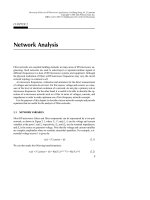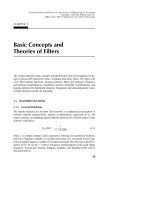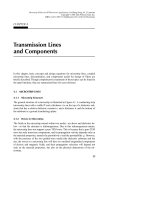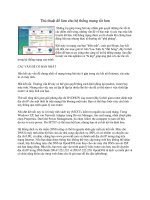Tài liệu Lò vi sóng RF và hệ thống không dây P3 pptx
Bạn đang xem bản rút gọn của tài liệu. Xem và tải ngay bản đầy đủ của tài liệu tại đây (907 KB, 44 trang )
CHAPTER THREE
Antenna Systems
3.1 INTRODUCTION
The study of antennas is very extensive and would need several texts to cover
adequately. In this chapter, however, a brief description of relevant performances and
design parameters will be given for introductory purposes.
An antenna is a component that radiates and receives the RF or microwave power.
It is a reciprocal device, and the same antenna can serve as a receiving or
transmitting device. Antennas are structures that provide transitions between
guided and free-space waves. Guided waves are confined to the boundaries of a
transmission line to transport signals from one point to another [1], while free-space
waves radiate unbounded. A transmission line is designed to have very little
radiation loss, while the antenna is designed to have maximum radiation. The
radiation occurs due to discontinuities (which cause the perturbation of fields or
currents), unbalanced currents, and so on.
The antenna is a key component in any wireless system, as shown in Fig. 3.1. The
RF=microwave signal is transmitted to free space through the antenna. The signal
propagates in space, and a small portion is picked up by a receiving antenna. The
signal will then be amplified, downconverted, and processed to recover the
information.
There are many types of antennas; Fig. 3.2 gives some examples. They can be
classified in different ways. Some examples are:
1. Shapes or geometries:
a. Wire antennas: dipole, loop, helix
b. Aperture antennas: horn, slot
c. Printed antennas: patch, printed dipole, spiral
67
RF and Microwave Wireless Systems. Kai Chang
Copyright # 2000 John Wiley & Sons, Inc.
ISBNs: 0-471-35199-7 (Hardback); 0-471-22432-4 (Electronic)
2. Gain:
a. High gain: dish
b. Medium gain: horn
c. Low gain: dipole, loop, slot, patch
3. Beam shapes:
a. Omnidirectional: dipole
b. Pencil beam: dish
c. Fan beam: array
FIGURE 3.1 Typical wireless system.
FIGURE 3.2 Various antennas [2].
68
ANTENNA SYSTEMS
4. Bandwidth:
a. Wide band: log, spiral, helix
b. Narrow band: patch, slot
Since antennas interface circuits to free space, they share both circuit and radiation
qualities. From a circuit point of view, an antenna is merely a one-port device with
an associated impedance over frequency. This chapter will describe some key
antenna properties, followed by the designs of various antennas commonly used
in wireless applications.
3.2 ISOTROPIC RADIATOR AND PLANE WAVES
An isotropic radiator is a theoretical point antenna that cannot be realized in practice.
It radiates energy equally well in all directions, as shown in Fig. 3.3. The radiated
energy will have a spherical wavefront with its power spread uniformly over the
surface of a sphere. If the source transmitting power is P
t
, the power density P
d
in
watts per square meters at a distance R from the source can be calculated by
P
d
¼
P
t
4R
2
ð3:1Þ
Although the isotropic antenna is not practical, it is commonly used as a reference
with which to compare other antennas.
At a distance far from the point source or any other antenna, the radiated spherical
wave resembles a uniform plane wave in the vicinity of the receiving antenna. This
can be understood from Fig. 3.4. For a large R, the wave can be approximated by a
uniform plane wave. The electric and magnetic fields for plane waves in free space
can be found by solving the Helmholtz equation
r
2
~
EE þ k
2
0
~
EE ¼ 0 ð3:2Þ
FIGURE 3.3 Isotropic radiator.
3.2 ISOTROPIC RADIATOR AND PLANE WAVES
69
where k
0
¼ 2=
0
. The solution is [1]
~
EE ¼
~
EE
0
e
Àj
~
kk
0
Á~rr
ð3:3Þ
The magnetic field can be found from the electric field using the Maxwell equation,
given by
~
HH ¼À
1
j!
0
rÂ
~
EE ¼
ffiffiffiffiffiffi
"
0
0
r
^
nn Â
~
EE ð3:4Þ
where
0
is the free-space permeability, "
0
is the free-space permittivity, ! is the
angular frequency, and k
0
is the propagation constant. Here,
~
kk
0
¼
^
nnk
0
, and
^
nn is
the unit vector in the wave propagation direction, as shown in Fig. 3.5. The vector E
0
is perpendicular to the direction of the propagation, and H is perpendicular to
~
EE and
^
nn. Both
~
EE and
~
HH lie in the constant-phase plane, and the wave is a TEM wave.
The intrinsic impedance of free space is defined as
0
¼
E
H
¼
ffiffiffiffiffiffi
0
"
0
r
¼ 120 or 377 ð3:5Þ
The time-averaged power density in watts per square meters is given as
P
d
¼
1
2
~
EE Â
~
HH*
¼
1
2
E
2
0
ð3:6Þ
FIGURE 3.4 Radiation from an antenna.
70
ANTENNA SYSTEMS
where the asterisk denotes the complex conjugate quantity. By equating Eq. (3.1)
and Eq. (3.6), one can find the electric field at a distance R from the isotropic
antenna as
E ¼
ffiffiffiffiffiffiffiffiffi
60P
t
p
R
¼
ffiffiffi
2
p
E
rms
ð3:7Þ
where E is the peak field magnitude and E
rms
is the root-mean-square (rms) value.
3.3 FAR-FIELD REGION
Normally, one assumes that the antenna is operated in the far-field region, and
radiation patterns are measured in the far-field region where the transmitted wave of
the transmitting antenna resembles a spherical wave from a point source that only
locally resembles a uniform plane wave. To derive the far-field criterion for the
distance R, consider the maximum antenna dimension to be D, as shown in Fig. 3.6.
We have
R
2
¼ðR À ÁlÞ
2
þð
1
2
DÞ
2
¼ R
2
À 2R Ál þðÁlÞ
2
þð
1
2
DÞ
2
ð3:8Þ
For R ) Ál, Eq. (3.8) becomes
2R Ál %
1
4
D
2
ð3:9Þ
FIGURE 3.5 Plane wave.
3.3 FAR-FIELD REGION
71
Therefore
R ¼
D
2
8 Ál
ð3:10Þ
If we let Ál ¼
1
16
0
, which is equivalent to 22:5
phase error, be the criterion for far-
field operation, we have
R
far field
¼
2D
2
0
ð3:11Þ
where
0
is the free-space wavelength. The condition for far-field operation is thus
given by
R !
2D
2
0
ð3:12Þ
It should be noted that other criteria could also be used. For example, if Ál ¼
1
32
0
or 11:25
phase error, the condition will become R ! 4D
2
=
0
for far-field operation.
FIGURE 3.6 Configuration used for calculation of far-field region criterion.
72
ANTENNA SYSTEMS
3.4 ANTENNA ANALYSIS
To analyze the electromagnetic radiation of an antenna, one needs to work in
spherical coordinates. Considering an antenna with a volume V and current
~
JJ
flowing in V , as shown in Fig. 3.7, the electric and magnetic fields can be found by
solving the inhomogeneous Helmholtz equation [1]:
r
2
~
AA þ k
2
0
~
AA ¼À
~
JJ ð3:13Þ
where
~
AA is the vector potential, defined as
~
BB ¼rÂ
~
AA ¼
0
~
HH ð3:14Þ
FIGURE 3.7 Antenna analysis: (a) spherical coordinates; (b) antenna and observation point.
3.4 ANTENNA ANALYSIS
73
The radiation is due to the current flow on the antenna, which contributes to a vector
potential at point Pðr;;Þ. This vector potential is the solution of Eq. (3.13), and
the result is given by [1]
~
AAð
~
rrÞ¼
4
ð
V
~
JJð
~
rr
0
Þ
e
Àjk
0
j
~
rrÀ
~
rr
0
j
j
~
rr À
~
rr
0
j
dV
0
ð3:15Þ
where r
0
is the source coordinate and r is the observation point coordinate. The
integral is carried over the antenna volume with the current distribution multiplied by
the free-space Green’s function, defined by
Free-space Green’s function ¼
e
Àjk
0
j
~
rrÀ
~
rr
0
j
j
~
rr À
~
rr
0
j
ð3:16Þ
If the current distribution is known, then
~
AAð
~
rrÞ can be determined. From
~
AAð
~
rrÞ, one can
find
~
HHð
~
rrÞ from Eq. (3.14) and thus the electric field
~
EEð
~
rrÞ. However, in many cases,
the current distribution is difficult to find, and numerical methods are generally used
to determine the current distribution.
3.5 ANTENNA CHARACTERISTICS AND PARAMETERS
There are many parameters used to specify and evaluate a particular antenna. These
parameters provide information about the properties and characteristics of an
antenna. In the following, these parameters will be defined and described.
3.5.1 Input VSWR and Input Impedance
As the one-port circuit, an antenna is described by a single scattering parameter S
11
or the reflection coefficient À, which gives the reflected signal and quantifies the
impedance mismatch between the source and the antenna. From Chapter 2, the input
VSWR and return loss are given by
VSWR ¼
1 þjÀj
1 ÀjÀj
ð3:17Þ
RL in dB ¼À20 logjÀjð3:18Þ
The optimal VSWR occurs when jÀj¼0 or VSWR ¼ 1. This means that all power
is transmitted to the antenna and there is no reflection. Typically, VSWR42is
acceptable for most applications. The power reflected back from the antenna is jÀj
2
times the power available from the source. The power coupled to the antenna is
ð1 ÀjÀj
2
Þ times the power available from the source.
74
ANTENNA SYSTEMS
The input impedance is the one-port impedance looking into the antenna. It is the
impedance presented by the antenna to the transmitter or receiver connected to it.
The input impedance can be found from À by
Z
in
¼ Z
0
1 þ À
1 À À
ð3:19Þ
where Z
0
is the characteristic impedance of the connecting transmission line. For a
perfect matching, the input impedance should be equal to Z
0
.
3.5.2 Bandwidth
The bandwidth of an antenna is broadly defined as the range of frequencies within
which the performance of the antenna, with respect to some characteristic, conforms
to a specified standard. In general, bandwidth is specified as the ratio of the upper
frequency to the lower frequency or as a percentage of the center frequency. Since
antenna characteristics are affected in different ways as frequency changes, there is
no unique definition of bandwidth. The two most commonly used definitions are
pattern bandwidth and impedance bandwidth.
The power entering the antenna depends on the input impedance locus of the
antenna over the frequencies. Therefore, the impedance bandwidth (BW) is the range
of frequencies over which the input impedance conforms to a specified standard.
This standard is commonly taken to be VSWR 2 (or jÀj
1
3
Þ and translates to a
reflection of about 11% of input power. Figure 3.8 shows the bandwidth definition
[2]. Some applications may require a more stringent specification, such as a VSWR
of 1.5 or less. Furthermore, the operating bandwidth of an antenna could be smaller
than the impedance bandwidth, since other parameters (gain, efficiency, patterns,
etc.) are also functions of frequencies and may deteriorate over the impedance
bandwidth.
3.5.3 Power Radiation Patterns
The power radiated (or received) by an antenna is a function of angular position and
radial distance from the antenna. At electrically large distances, the power density
drops off as 1=r
2
in any direction. The variation of power density with angular
position can be plotted by the radiation pattern. At electrically large distances (i.e.,
far-field or plane-wave regions), the patterns are independent of distance.
The complete radiation properties of the antenna require that the electric or
magnetic fields be plotted over a sphere surrounding the antenna. However, it is
often enough to take principal pattern cuts. Antenna pattern cuts are shown in Fig.
3.9. As shown, the antenna has E- and H-plane patterns with co- and cross-
polarization components in each. The E-plane pattern refers to the plane containing
the electric field vector ðE
Þ and the direction of maximum radiation. The parameter
E
is the cross-polarization component. Similarly, the H-plane pattern contains the
magnetic field vector and the direction of maximum radiation. Figure 3.10 shows an
antenna pattern in either the E-orH-plane. The pattern contains information about
half-power beamwidth, sidelobe levels, gain, and so on.
3.5 ANTENNA CHARACTERISTICS AND PARAMETERS
75
FIGURE 3.8 VSWR ¼ 2 bandwidth [2].
FIGURE 3.9 Antenna pattern coordinate convention [2].
76
ANTENNA SYSTEMS
3.5.4 Half-Power Beamwidth and Sidelobe Level
The half-power beamwidth (HPBW) is the range in degrees such that the radiation
drops to one-half of (or 3 dB below) its maximum. The sidelobes are power radiation
peaks in addition to the main lobe. The sidelobe levels (SLLs) are normally given as
the number of decibels below the main-lobe peak. Figure 3.10 [2] shows the HPBW
and SLLs. Also shown is FNBW, the first-null beamwidth.
3.5.5 Directivity, Gain, and Efficiency
The directivity D
max
is defined as the value of the directive gain in the direction of its
maximum value. The directive gain Dð; Þ is the ratio of the Poynting power density
Sð; Þ over the power density radiated by an isotropic source. Therefore, one can
write
Dð; Þ¼
Sð; Þ
P
t
=4R
2
ð3:20Þ
D
max
¼
maximum of Sð; Þ
P
t
=4R
2
ð3:21Þ
where
~
SSð; Þ¼
1
2
Re½
~
EE Â
~
HH*.
The directivity of an isotropic antenna equals to 1 by definition, and that of other
antennas will be greater than 1. Thus, the directivity serves as a figure of merit
relating the directional properties of an antenna relative to those of an isotropic
source.
The gain of an antenna is the directivity multiplied by the illumination or aperture
efficiency of the antenna to radiate the energy presented to its terminal:
Gain ¼ G ¼ D
max
ð3:22Þ
¼ efficiency ¼
P
rad
P
in
¼
P
rad
P
rad
þ P
loss
ð3:23Þ
FIGURE 3.10 Antennas pattern characteristics [2].
3.5 ANTENNA CHARACTERISTICS AND PARAMETERS
77
where P
rad
is the actual power radiated, P
in
is the power coupled into the antenna,
and P
loss
is the power lost in the antenna. The losses could include ohmic or
conductor loss, dielectric loss, and so on. In general, the narrower the beamwidth,
the higher the gain. Figure 3.11 gives a comparison of gain for three different
antennas. From Eqs. (3.21) and (3.22), the radiated power density in the direction of
its maximum value is P
d;max
¼ GðP
t
=4R
2
Þ.
3.5.6 Polarization and Cross-Polarization Level
The polarization of an antenna is the polarization of the electric field of the radiated
wave. Antennas can be classified as linearly polarized (LP) or circularly polarized
(CP). The polarization of the wave is described by the tip of the E-field vector as
time progresses. If the locus is a straight line, the wave is linearly polarized. If the
locus is a circle, the wave is circularly polarized. Ideally, linear polarization means
that the electric field is in only one direction, but this is seldom the case. For linear
polarization, the cross-polarization level (CPL) determines the amount of polariza-
tion impurity. As an example, for a vertically polarized antenna, the CPL is due to
the E-field existing in the horizontal direction. Normally, CPL is a measure of
decibels below the copolarization level.
3.5.7 Effective Area
The effective area ðA
e
Þ is related to the antenna gain by
G ¼
4
2
0
A
e
ð3:24Þ
FIGURE 3.11 Gain comparison [2].
78
ANTENNA SYSTEMS
It is easier to visualize the concept of effective area when one considers a receiving
antenna. It is a measure of the effective absorbing area presented by an antenna to an
incident wave [3]. The effective area is normally proportional to, but less than, the
physical area of the antenna.
3.5.8 Beam Efficiency
Beam efficiency is another frequently used parameter to gauge the performance of an
antenna. Beam efficiency is the ratio of the power received or transmitted within a
cone angle to the power received or transmitted by the whole antenna. Thus, beam
efficiency is a measure of the amount of power received or transmitted by minor
lobes relative to the main beam.
3.5.9 Back Radiation
The back radiation is directed to the backside of an antenna. Normally it is given as
the back-to-front ratio in decibels.
3.5.10 Estimation of High-Gain Antennas
There are some convenient formulas for making quick estimates of beamwidths and
gains of electrically large, high gain antennas. A convenient equation for predicting a
3-dB beamwidth is [3]:
BW ¼ K
1
0
D
ð3:25Þ
where D is the aperture dimension in the plane of the pattern. For a rough estimate,
one can use K
1
¼ 70
. For an example, if the length of an antenna is 10 cm, the
beamwidth at 30 GHz, in the plane of length, is 7
.
A convenient equation for predicting gain is given in reference [3]:
G ¼
K
2
1
2
ð3:26Þ
where K
2
is a unitless constant and
1
and
2
are the 3-dB beamwidths in degrees in
the two orthogonal principal planes. The correct K
2
value depends on antenna
efficiency, but a rough estimate can be made with K
2
¼ 30,000.
Example 3.1 The E-plane pattern of an eight-element microstrip patch antenna
array is shown in Fig. 3.12 [4]. Describe the characteristics of this pattern.
Solution From the pattern shown in Fig. 3.12, it can be seen that the gain is
11.4 dB. The half-power beamwidth is about 22:2
. The cross-polarization radiation
level is over 26 dB below the copolarization radiation in the main beam. The first
3.5 ANTENNA CHARACTERISTICS AND PARAMETERS
79
SLL is about 14 dB below the main lobe. The maximum back radiation occurs at
around 135
with a level of about 13 dB below the main-lobe peak. j
3.6 MONOPOLE AND DIPOLE ANTENNAS
The monopole and dipole antennas are commonly used for broadcasting, cellular
phones, and wireless communications due to their omnidirective property. Figure
3.13 shows some examples. A monopole together with its image through a metal or
ground plane has radiation characteristics similar to a dipole. A dipole with a length l
is approximately equivalent to a monopole with a length of
1
2
l placed on a metal or
ground plane. For a dipole with a length l <
0
, the E-plane radiation pattern is a
doughnut shape with a hole or figure-eight shape, as shown in Fig. 3.14. The
maximum radiation occurs when ¼ 90
and there is no radiation at ¼ 0
. The H-
plane radiation pattern is a circle, which means the antenna radiates equally in all
directions. Therefore, it is nondirective in the direction. Since it is only directive in
the direction, it is called an omnidirective antenna. Because it is nondirective in the
direction, the antenna can receive a signal coming from any direction in the H-
plane. This makes the antenna useful for broadcast and wireless applications. The
antenna has no gain in the H-plane, that is, G ¼ 1. In the E-plane pattern, the gain is
fairly low since it has a broad beamwidth.
FIGURE 3.12 E-plane pattern of an eight-element microstrip patch antenna fed by an image
line operating at 31.3 GHz. (From reference [4], with permission from IEEE.)
80
ANTENNA SYSTEMS
By assuming a sinusoidal current distribution on the dipole, the radiated fields
can be found from Eqs. (3.14) and (3.15) [5]. Figure 3.15 shows the pattern plots for
different dipole length l’s [3]. It can be seen that the pattern deteriorates from its
figure-eight shape when l >
0
. In most cases, a dipole with l <
0
is used.
When l ¼
1
2
0
, it is called a half-wave dipole. A half-wave dipole (or a quarter-
wavelength monopole) has an input impedance approximately equal to 73 and an
antenna gain of 1.64. For a very short dipole with l (
0
, the input impedance is
very small and difficult to match. It has low efficiency, and most power is wasted.
The gain for a short dipole is approximately equal to 1.5 (or 1.7 dB).
In practice, the antenna is always fed by a transmission line. Figure 3.16 shows a
quarter-wavelength monopole for mobile communication applications. This type of
antenna normally uses a flexible antenna element and thus is called the quarter-
FIGURE 3.13 Examples of dipole and monopole antennas.
3.6 MONOPOLE AND DIPOLE ANTENNAS
81
FIGURE 3.14 (a) Thin-wire dipole and monopole antenna. (b) E- and H-plane radiation
patterns. (c) Three-dimensional view of the radiation pattern.
82
ANTENNA SYSTEMS
wavelength ‘‘ whip’’ antenna. The antenna is mounted on the ground plane, which is
the roof of a car. If the ground plane is assumed to be very large and made of a
perfect conductor, the radiation patterns of this antenna would be the same as that of
a half-wave dipole. However, the input impedance is only half that of a half-wave
dipole.
There are various types of dipoles or monopoles used for wireless applications. A
folded dipole is formed by joining two cylindrical dipoles at the ends, as shown in
Fig. 3.17. The excitation of a folded dipole can be considered as a superposition of
two modes, a symmetrical mode and an asymmetrical mode [6].
Figure 3.18 shows a sleeve antenna [7]. The coaxial cylindrical skirt behaves as a
quarter-wavelength choke, preventing the antenna current from leaking into the outer
surface of the coaxial cable. The choke on the lower part of the coaxial cable is used
to improve the radiation pattern by further suppressing the current leakage. This
antenna does not require a ground plane and has almost the same characteristics as
that of a half-wavelength dipole antenna. The feeding structure is more suitable for
vehicle mounting than the center-fed dipole antenna.
Other variations of monopole antennas are inverted L and inverted F antennas, as
shown in Figs. 3.19a and b. These are low-profile antennas formed by bending a
quarter-wavelength monopole element mounted on a ground plane into an L-shape
or F-shape. The wire can be replaced by a planar element with wide-band
characteristics [7]. The modified structure is shown in Fig. 3.19c. These types of
antennas are used on hand-held portable telephones.
FIGURE 3.16 Quarter-wavelength whip antenna and its pattern.
FIGURE 3.15 Radiation patterns of center-driven dipole assuming sinusoidal current
distribution and very thin dipole. (From reference [3], with permission from McGraw-Hill.)
Publishers Note:
Permission to reproduce this image online was not granted
by the copyright holder. Readers are kindly asked to
refer to the printed version of this chapter.
3.6 MONOPOLE AND DIPOLE ANTENNAS
83









